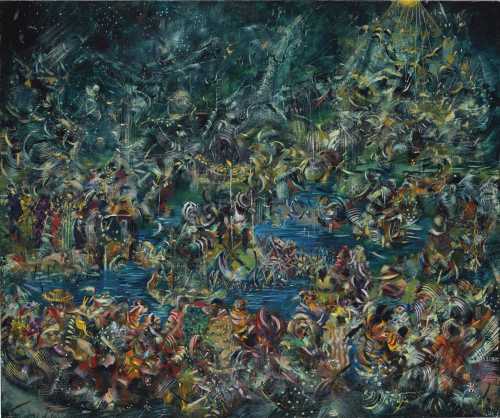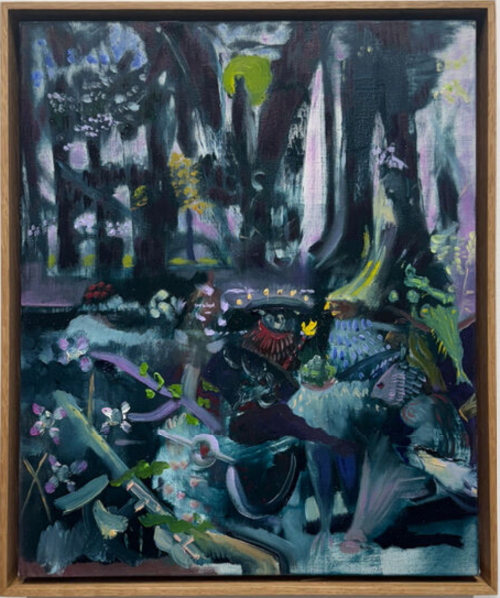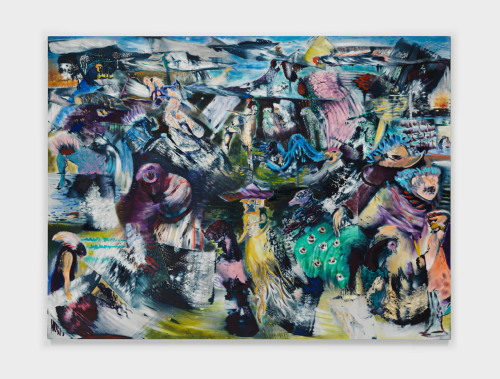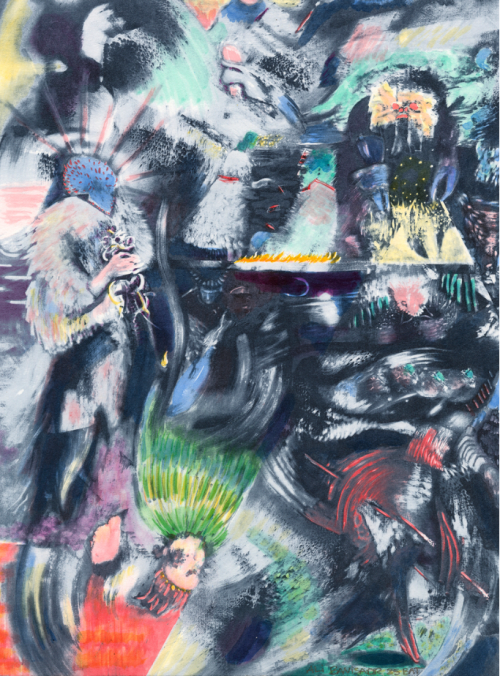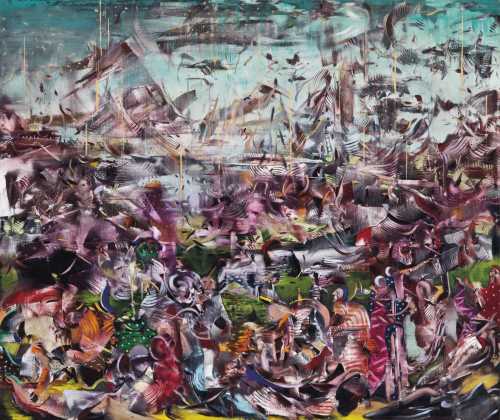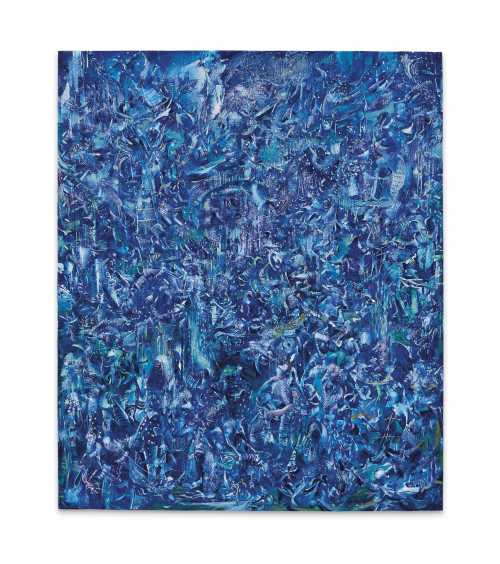- The Light 2010
- Oil on canvas
- Painting
- 91.5 * 76.5 cm
- signed and dated 'Ali Banisadr 2010' (lower right); signed and dated 'Ali Banisadr 2010' (on the overlap)
Artwork Description
Contemporary artist Ali Banisadr’s works remain deeply informed by a childhood spent in a country in turmoil. Born in 1975 in Tehran, Banisadr moved to the US as a child (after a brief stint in Turkey) and carried with him his distraught memories of the Iran-Iraq war and the trauma of the continued bombings during nightly air raids in Tehran which led to his forced displacement. Representing the residues of memories from his war-torn childhood, his oeuvre is intended to be seen and heard. As an artist he has embarked on a quest to make sense of the events and sounds that shattered the integrity of objects and lives and his practice expresses his experience of belonging to two distinct cultures, both western and that of his native Iran, filtered through the edifying prism of art historical references from medieval imagery to abstract expressionism. The artist himself has avowed that the subject matter of his paintings 'is based on three things: the history of myself, the history of our century, and the history of art. These things aren't going to change much.' (The artist quoted in J. Beer, “Conversation with the Unnamed: Ali Banisadr”, in Art-Rated, January 2012, accessed online).
Richly allusive with its stunning atmospheric effects, his apocalyptic semi-abstract paintings are distinguished by their highly keyed palettes, competing velocities and multiple and simultaneous perspectives ranging from focused details to bird’s-eye views. Populated by aggressively interacting hybridisations of figures that are embroiled in intense engagements in an almost theatrical scene, it becomes evidently clear that his oeuvre encompasses a vast range of references. The rhythm and spontaneity of his works hint to his practice of graffiti art in California in the early 1990s and his interest in the New York art scene of the time, namely works by Jean-Michel Basquiat and Keith Haring that he discovered as a young adult when he moved to the East coast to pursue his education. On the other hand, the hundreds of intricate miniature figures that swarm across his fantastical landscapes evoke Persian miniatures, late medieval Netherlandish and Renaissance Venetian painting, Japanese wood-block prints, films and comic books, in an amalgamation that is preceded by a dazzling array of Abstract Expressionist-like brushwork.
Banisadr's Bacchanalian scenes oscillate between violence and pleasure, the narrative element emerging from the process of painting itself. Combining abstract brushwork and an assured gesturality, Banisadr allows the suggestion of figures and objects within the landscape to simultaneously emerge and recede. Upon closer inspection, stories dissolve into a rhythm of colours and shapes, leaving an impression of decadent destruction that becomes less about individual figuration than the very impression of swarming movement; a narrative scene transforming into an abstract insurgence before one's eyes. This oscillation between human narrative and abstraction forms the core of Banisadr's practice.
A seminal work from his earlier series of 2010, Christie’s is delighted to be offering the impressive work entitled The Light where through a combination of quick successive brushstrokes and varied palette, Banisadr creates a fantastical zone where the fabric of reality is twisted and altered by the subconscious, intersected by memories and augmented by the imagination.
Despite the all over energising of his canvases, in The Light Banisadr achieves a strong sense of pictorial depth, with fore, middle and long distance, a clear horizon between sky and ground. There is an added sense of depth in the variety of scale amongst his heaving horde. In the centre, the focus appears to be on a central abstracted figure which can be interpreted as riding on a horse. Although one’s eye is drawn to this central motif, an assessment of the composition in its entirety captures the viewer’s eye in several areas of the compositions, thus it is no longer about a central focus; the eye must travel inside the frame and treat these varying details as a slowly unfolding drama delivered on a theatre stage. Indeed as Banisadr himself puts it, ‘…Everything is in motion. Everything is in a state of flux. I never liked anything to be static because when it is static it becomes similar to a central point. I am not trying to create one central focus, ideally, I want the whole piece to be a central focus. I want to show a system as opposed to a focal point, or to having a ‘hero’. I want everything – the figures, the land, the sky – to have equal importance.’ (The artist quoted in O. Sand, “Ali Banisadr”, in Asian Art, February 2011, p. 5).
The Light has the allure of another world; although there is a clear definition of both land and sky, his surface is inviting and mysterious, poised between the limits of understanding and the possibilities of the imagination. The shimmering marks coalesce as figures in landscapes, slipping between formed and formless, recalling the frenetic scenes of the fifteenth century painter Hieronymus Bosch and his seminal work The Garden of Earthly Delights in which countless human figures revel in an innocent joy as they engage in sensory pleasures and primeval activities. Banisadr’s bestiary of varyingly gruesome, comical, menacing and preposterous personages formed in an equally fulsome array of gestures – artful smudges and splatters, striation sand strokes, virtuoso flicks of wrist and bravura sleights of hand offer a sense of balance, movement, harmony and dissonance, detail and whole that is exemplified by a gradient colour palette shifting from light blue of the water to the dark hellish blacks in the sky, broken by the beacon of hope, the light, that shines brightly through.
Seemingly abstract and set in historical reference, these meticulous layers of paint evoke the denseness of history and speak to the simultaneous unfolding of events one witnesses in the current world. Although cemented in memories and traumas of the past, through technique, Banisadr infuses The Light with layers with poetry that communicate far beyond his ideas, allowing the audience to find their own fiction in the picture. Conflating past and present, the Orient and the Occident, personal experience, myth, history and current events, The Light is undeniably an exceptional painting that scintillates and dazzles.
Richly allusive with its stunning atmospheric effects, his apocalyptic semi-abstract paintings are distinguished by their highly keyed palettes, competing velocities and multiple and simultaneous perspectives ranging from focused details to bird’s-eye views. Populated by aggressively interacting hybridisations of figures that are embroiled in intense engagements in an almost theatrical scene, it becomes evidently clear that his oeuvre encompasses a vast range of references. The rhythm and spontaneity of his works hint to his practice of graffiti art in California in the early 1990s and his interest in the New York art scene of the time, namely works by Jean-Michel Basquiat and Keith Haring that he discovered as a young adult when he moved to the East coast to pursue his education. On the other hand, the hundreds of intricate miniature figures that swarm across his fantastical landscapes evoke Persian miniatures, late medieval Netherlandish and Renaissance Venetian painting, Japanese wood-block prints, films and comic books, in an amalgamation that is preceded by a dazzling array of Abstract Expressionist-like brushwork.
Banisadr's Bacchanalian scenes oscillate between violence and pleasure, the narrative element emerging from the process of painting itself. Combining abstract brushwork and an assured gesturality, Banisadr allows the suggestion of figures and objects within the landscape to simultaneously emerge and recede. Upon closer inspection, stories dissolve into a rhythm of colours and shapes, leaving an impression of decadent destruction that becomes less about individual figuration than the very impression of swarming movement; a narrative scene transforming into an abstract insurgence before one's eyes. This oscillation between human narrative and abstraction forms the core of Banisadr's practice.
A seminal work from his earlier series of 2010, Christie’s is delighted to be offering the impressive work entitled The Light where through a combination of quick successive brushstrokes and varied palette, Banisadr creates a fantastical zone where the fabric of reality is twisted and altered by the subconscious, intersected by memories and augmented by the imagination.
Despite the all over energising of his canvases, in The Light Banisadr achieves a strong sense of pictorial depth, with fore, middle and long distance, a clear horizon between sky and ground. There is an added sense of depth in the variety of scale amongst his heaving horde. In the centre, the focus appears to be on a central abstracted figure which can be interpreted as riding on a horse. Although one’s eye is drawn to this central motif, an assessment of the composition in its entirety captures the viewer’s eye in several areas of the compositions, thus it is no longer about a central focus; the eye must travel inside the frame and treat these varying details as a slowly unfolding drama delivered on a theatre stage. Indeed as Banisadr himself puts it, ‘…Everything is in motion. Everything is in a state of flux. I never liked anything to be static because when it is static it becomes similar to a central point. I am not trying to create one central focus, ideally, I want the whole piece to be a central focus. I want to show a system as opposed to a focal point, or to having a ‘hero’. I want everything – the figures, the land, the sky – to have equal importance.’ (The artist quoted in O. Sand, “Ali Banisadr”, in Asian Art, February 2011, p. 5).
The Light has the allure of another world; although there is a clear definition of both land and sky, his surface is inviting and mysterious, poised between the limits of understanding and the possibilities of the imagination. The shimmering marks coalesce as figures in landscapes, slipping between formed and formless, recalling the frenetic scenes of the fifteenth century painter Hieronymus Bosch and his seminal work The Garden of Earthly Delights in which countless human figures revel in an innocent joy as they engage in sensory pleasures and primeval activities. Banisadr’s bestiary of varyingly gruesome, comical, menacing and preposterous personages formed in an equally fulsome array of gestures – artful smudges and splatters, striation sand strokes, virtuoso flicks of wrist and bravura sleights of hand offer a sense of balance, movement, harmony and dissonance, detail and whole that is exemplified by a gradient colour palette shifting from light blue of the water to the dark hellish blacks in the sky, broken by the beacon of hope, the light, that shines brightly through.
Seemingly abstract and set in historical reference, these meticulous layers of paint evoke the denseness of history and speak to the simultaneous unfolding of events one witnesses in the current world. Although cemented in memories and traumas of the past, through technique, Banisadr infuses The Light with layers with poetry that communicate far beyond his ideas, allowing the audience to find their own fiction in the picture. Conflating past and present, the Orient and the Occident, personal experience, myth, history and current events, The Light is undeniably an exceptional painting that scintillates and dazzles.
Realized Price
218,606 USD
Min Estimate
125,765 USD
Max Estimate
178,204 USD
Average Artwork Worth
+54.349%
Average Growth of Artwork Worth
Sales Performance Against Estimates
Average & Median Sold Lot Value
2021 - 2025
Performance vs. Estimate
2021 - 2025
Sell-through Rate
2021 - 2025
Similar Artworks
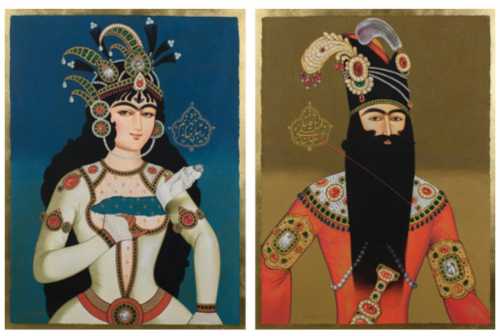
End of an Era from the Memories of Destruction series
Estimation
100,000,000,000﷼
166,667 USD
-
120,000,000,000﷼
200,000 USD
Realized Price
123,200,000,000﷼
205,333 USD
12%
Sale Date
Tehran
-
5 July 2024
